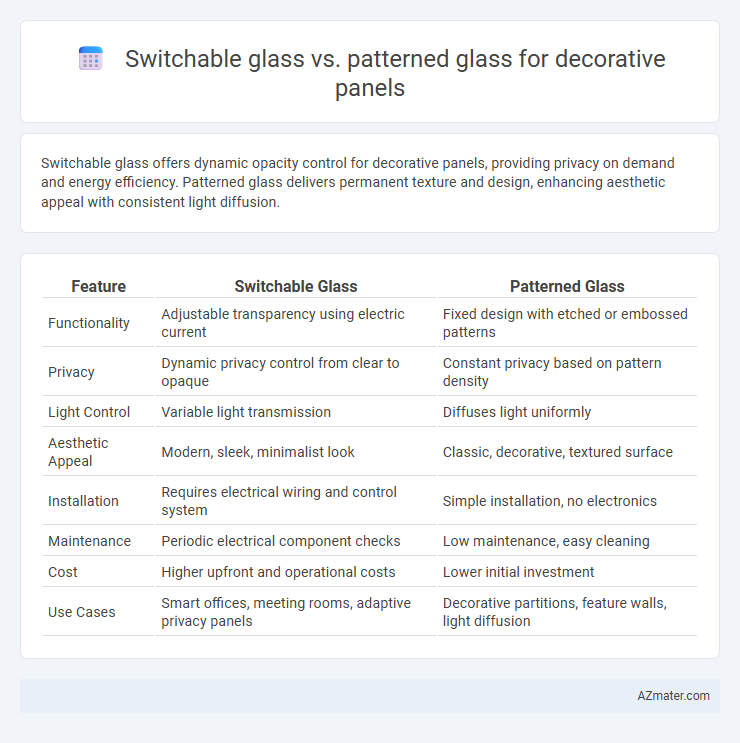Switchable glass offers dynamic opacity control for decorative panels, providing privacy on demand and energy efficiency. Patterned glass delivers permanent texture and design, enhancing aesthetic appeal with consistent light diffusion.
Table of Comparison
| Feature | Switchable Glass | Patterned Glass |
|---|---|---|
| Functionality | Adjustable transparency using electric current | Fixed design with etched or embossed patterns |
| Privacy | Dynamic privacy control from clear to opaque | Constant privacy based on pattern density |
| Light Control | Variable light transmission | Diffuses light uniformly |
| Aesthetic Appeal | Modern, sleek, minimalist look | Classic, decorative, textured surface |
| Installation | Requires electrical wiring and control system | Simple installation, no electronics |
| Maintenance | Periodic electrical component checks | Low maintenance, easy cleaning |
| Cost | Higher upfront and operational costs | Lower initial investment |
| Use Cases | Smart offices, meeting rooms, adaptive privacy panels | Decorative partitions, feature walls, light diffusion |
Introduction to Decorative Glass Panels
Decorative glass panels enhance interior design by combining functionality with aesthetics, where switchable glass offers privacy control through smart technology that shifts from transparent to opaque upon electric activation. Patterned glass features etched or embossed designs that create texture and visual interest while diffusing light, making it ideal for adding decorative elements without electronic components. Both options serve unique design needs in residential and commercial spaces, with switchable glass providing dynamic privacy and patterned glass delivering timeless decorative appeal.
What is Switchable Glass?
Switchable glass, also known as smart glass or privacy glass, is an innovative type of glass that can change from transparent to opaque with the application of an electrical current. This technology uses a layer of liquid crystal or polymer dispersed liquid crystal (PDLC) film embedded between two layers of glass, allowing instant control over privacy and light transmission. In decorative panels, switchable glass offers dynamic privacy solutions and customizable aesthetics, unlike patterned glass which relies on static etched or printed designs for decoration.
What is Patterned Glass?
Patterned glass is a textured type of glass featuring various embossed or etched designs that offer both privacy and decorative appeal in panel applications. This glass type diffuses light while obscuring vision, making it ideal for spaces requiring light transmission without clear visibility. Unlike switchable glass, which changes transparency electronically, patterned glass has a fixed design and permanent privacy feature.
Aesthetic Differences: Switchable vs Patterned Glass
Switchable glass offers a sleek, modern aesthetic with its ability to transition from transparent to opaque, creating dynamic visual effects and privacy on demand. Patterned glass provides consistent decorative textures or designs, adding tactile depth and traditional ornamental appeal without changing transparency. While switchable glass emphasizes functional elegance and versatility in interior design, patterned glass focuses on fixed artistic expression through various motifs and patterns.
Functionality and Versatility Comparison
Switchable glass offers dynamic privacy control through electrochromic technology, enabling users to toggle between transparent and opaque states instantly, making it ideal for adaptable environments. Patterned glass provides consistent decorative aesthetics with etched or textured designs, enhancing visual appeal while allowing light diffusion but lacks the flexibility of real-time opacity changes. Both materials serve decorative purposes, yet switchable glass excels in multifunctionality and user-controlled ambiance, whereas patterned glass delivers static, durable design options.
Privacy Control: Switchable vs Patterned Glass
Switchable glass offers dynamic privacy control by instantly changing from transparent to opaque with the flick of a switch, allowing users to customize visibility on demand. Patterned glass provides fixed privacy through etched or embossed designs that obscure views while maintaining light transmission but lacks adjustable opacity. For environments needing flexible privacy solutions, switchable glass outperforms patterned glass in adaptability and user control.
Installation and Maintenance Considerations
Switchable glass requires precise electrical wiring and professional installation to ensure flawless functionality, while patterned glass installs similarly to conventional glass panels without electrical components. Maintenance for switchable glass involves routine cleaning with non-abrasive materials and periodic checks of the wiring and control systems to prevent operational failures. Patterned glass demands standard glass care, focusing on preserving texture and finish, with minimal specialized maintenance compared to the more complex requirements of switchable glass.
Cost Analysis of Switchable and Patterned Glass
Switchable glass typically incurs higher upfront costs due to its advanced technology involving embedded electrically conductive layers and control systems, often costing 3 to 5 times more than patterned glass. Patterned glass, produced through affordable rolling or etching techniques, offers a budget-friendly alternative suitable for decorative panels without requiring electrical components. Over time, switchable glass may result in increased operational expenses related to electricity usage and maintenance, whereas patterned glass remains a one-time investment with minimal ongoing costs.
Sustainability and Energy Efficiency Factors
Switchable glass significantly enhances energy efficiency by controlling light and heat transmission, reducing reliance on artificial lighting and HVAC systems, which lowers overall energy consumption. Patterned glass contributes to sustainability by offering durability and requiring less processing, but it lacks the dynamic control over solar gain and privacy provided by switchable glass. Integrating switchable glass in decorative panels supports green building certifications through improved thermal regulation and reduced carbon footprint.
Choosing the Right Glass for Decorative Panels
Switchable glass offers dynamic opacity control, making it ideal for privacy and modern aesthetic in decorative panels, while patterned glass provides fixed textures and designs that enhance visual interest and diffuse light. Selecting the right glass depends on the desired functionality: choose switchable glass for versatile, customizable transparency and patterned glass for timeless decoration with consistent light diffusion. Consider factors such as light control, privacy needs, and design style to optimize decorative panel performance and appearance.

Infographic: Switchable glass vs Patterned glass for Decorative panel
 azmater.com
azmater.com